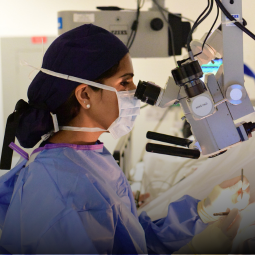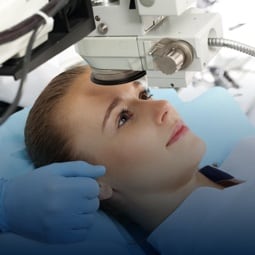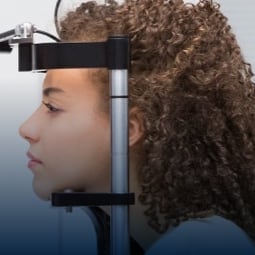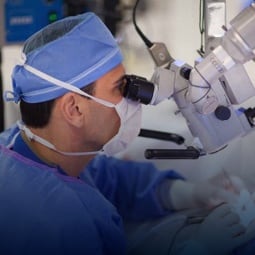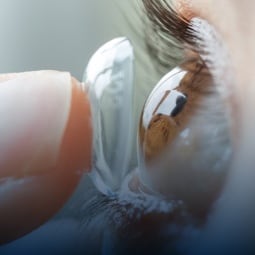
Achieve Clear Vision With LASIK
For over 30 years, the surgeons at Center For Sight have helped individuals enjoy improved vision. We are pleased to offer many of the latest refractive surgical procedures, including LASIK, Photorefractive keratectomy (PRK, intra-corneal implants, and implantable contact lenses (ICL).
Each person’s vision goals are unique—our ophthalmologists can explain which vision correction option is best for your needs. Visit one of our locations and see how we can improve your eyesight.
Dr. Jon R. Berlie is a board-certified ophthalmologist who specializes in LASIK and premium lens cataract surgery.
Dr. Berlie continued his education at the University of Nebraska Medical Center where he completed his ophthalmology residency and received the awards of Chief Resident and the Resident of the Year Award. Dr. Berlie then went on to Saint Anthony Hospital in Oklahoma City to complete his fellowship training in Oculoplastic and Aesthetic Laser Surgery.
Dr. Joaquin De Rojas is a board-certified ophthalmologist who is a fellowship-trained cataract, refractive, LASIK and corneal surgeon. He earned his medical degree from the Perelman School of Medicine at the University of Pennsylvania.
He completed his surgical internship and ophthalmology residency training at Columbia University Medical Center, where he was Chief Surgical Resident, followed by a Cornea, External Diseases, and Refractive Surgery fellowship at the Johns Hopkins Wilmer Eye Institute.
Dr. Priya Mathews is a board-certified ophthalmologist who is a fellowship-trained cataract, refractive, LASIK and corneal surgeon. She received her Medical Degree from Johns Hopkins University, and also earned her Master’s in Public Health with a concentration in epidemiology and biostatistics.
Dr. Mathews specializes in cataract, cornea, and refractive surgery. She is an expert in the diagnosis and management of cornea and external diseases, including Keratoconus, Fuchs’ Dystrophy, autoimmune diseases, and severe dry eye disease.
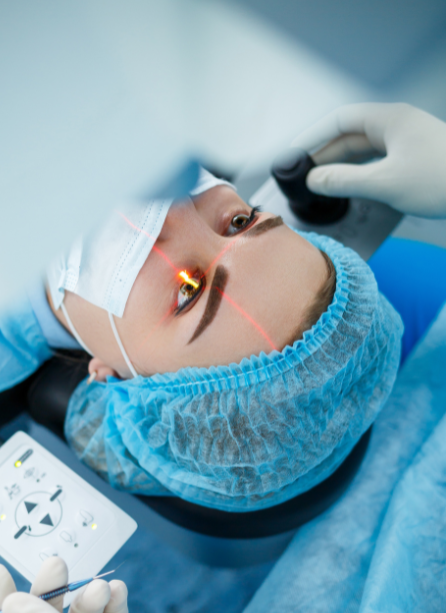

Modern LASIK
LASIK, or laser-assisted in-situ keratomileusis, is one of the most popular and precise vision procedures available today to correct different refractive errors. With the specialized technology Center For Sight has helped pioneer, we use a combination of laser technology to perform blade-free LASIK with micron-level precision and accuracy.

How LASIK Works
The LASIK procedure involves 2 steps: making a flap and then reshaping the cornea with the excimer laser. At Center For Sight, we use the IntraLase laser to create a flap to help our surgeons access the cornea. With assistance from the WaveLight EX500 excimer laser with wavefront technology, our surgeons reshape your cornea to provide you with improved vision.
Our topography-guided laser can help provide customized laser treatment based on your unique cornea shape.
Advantages of Blade-Free LASIK
There are several advantages to our blade-free LASIK procedure, including:
- Improved safety
- Better vision
- The highest degree of predictability
- Reduced dry eye symptoms
- Individualized flaps
PRK (Photorefractive keratectomy)
Another vision-correcting procedure is Photorefractive keratectomy (PRK). This surgery involves reshaping the cornea directly on the surface rather than through a flap, like LASIK. PRK is ideal for people with thin corneas or other corneal conditions.
We reshape the cornea with help from the WaveLight EX500 excimer laser after removing the outer layer of the cornea (epithelium). A contact lens bandage then goes over the treatment area to offer protection and comfort during the healing process. The recovery process for PRK is longer than LASIK, taking several days for the epithelium to regenerate and the eye to heal.
Implantable Contact Lens
An implantable contact lens (ICL) is a lens placed inside of the eye. It differs from other intraocular lens implants because the natural lens does not need to be removed when placing the ICL. The lens tucks behind the iris, providing clearer vision.
If needed, an ICL can be removed and replaced if your refractive error changes with time.

What is the EVO ICl Lens?
EVO ICL is an Implantable Collamer™ Lens that corrects common vision problems such as nearsightedness (myopia) and astigmatism. Collamer is a biocompatible material that works in harmony with the eye. The lens, which is slightly smaller than a typical contact lens, is implanted in the eye during a 20 to 30 minute procedure. Unlike laser vision correction surgeries that permanently change the shape of your cornea, the EVO ICL procedure is additive, meaning that no corneal tissue is removed. Worldwide, more than 1 million EVO Visian ICL lenses have been implanted.
What are the Benefits of EVO ICL?
EVO ICL offers many benefits for patients who are candidates for the ICL procedure and are seeking a vision solution that allows them the freedom of less dependence on glasses or contact lenses. The advantages of EVO ICL include:
- Sharp, clear vision
- Excellent night vision
- Does not cause dry eye syndrome
- Quick procedure and recovery
- No removal of corneal tissue
- Removable by your doctor
- Protection from UV Rays

Who is a Candidate for Vision Correction with EVO ICL?
People who want a flexible and biocompatible vision correction option, as well as many patients who are not candidates for laser vision correction, find that EVO ICL is the right procedure for them.
Ideal candidates for EVO ICL:
- Are between the ages of 21 and 45
- Are seeking a vision correction solution for moderate to severe nearsightedness (with or without astigmatism)
- Have a stable prescription that has not changed within the last year
- Have good ocular health with no history of glaucoma, iritis, or diabetic eye disease
How is the EVO ICL Lens Procedure Performed?
Vision correction with the EVO ICL is an outpatient procedure that typically takes 20 to 30 minutes. After an initial exam with your ophthalmologist to determine that the EVO ICL is right for you, you will schedule your procedure. On the day of the procedure, your eyes will be numbed with an anesthetic eye drop and your refractive surgeon will implant the ICL between the iris (colored part of the eye) and the natural lens. Your surgeon will likely schedule a follow-up appointment the same day as the procedure.
Can the EVO ICL Lens be Removed?
Yes, the EVO ICL is intended to provide permanent vision correction, but it can be removed or upgraded by your surgeon.
Will I be able to feel the EVO ICL Lens?
No, patients should not feel the lens as it does not adhere to any structures within the eye and does not move once in place.
Will other people be able to see the EVO ICL Lens?
No, the EVO lens is placed behind your iris where only your eye doctor will be able to detect it.
Are there any risks with the EVO ICL Procedure?
Any medical procedure has certain risks associated with it. Potential complications of the EVO ICL procedure, although rare, include inflammation, an increase in eye pressure, or the need for an additional procedure, like an ICL exchange. While these potential risks are mitigated as much as possible, they can all typically be addressed early and without long-term side effects.

Our Success Stories Videos
FAQ’s
How experienced are the Center for Sight’s LASIK surgeons?
Our LASIK surgeons are highly experienced and board-certified ophthalmologists. They have undergone extensive training at prestigious institutions, including Johns Hopkins University, Columbia University Medical Center, and the University of Pennsylvania. With decades of combined experience, they have performed thousands of successful LASIK procedures, ensuring the highest level of care and precision.
Is Center for Sight considered one of the best LASIK providers in Florida?
Yes, Center for Sight is widely recognized as one of the leading LASIK providers in Florida. With over 30 years of expertise in vision correction and a commitment to using the latest technology, we have earned a reputation for delivering exceptional results and personalized care.
What vision problems can LASIK correct?
LASIK can correct common refractive errors, including nearsightedness (myopia), farsightedness (hyperopia), and astigmatism. By reshaping the cornea with advanced laser technology, LASIK helps improve vision clarity and reduces dependence on glasses or contact lenses.
Does LASIK hurt?
LASIK is a virtually painless procedure. Numbing eye drops are applied before the surgery to ensure comfort. While you may feel slight pressure during the procedure, most patients report minimal discomfort and a quick recovery.
Love Life Without Glasses
At Center For Sight, we have several ways to help improve your vision. Our experienced doctors can help you choose the vision correction option allowing you the greatest opportunity to minimize dependence on glasses or contacts. Contact us today to see how we can help.

Our Locations

News
How Long Does a Facelift Last? Factors That Shape Your Results
Faces by FezzaWhat a Facelift Does and How Longevity Works A surgical facelift procedure lifts and repositions deeper facial tissues while smoothing lax skin. Results last because underlying support layers are addressed, not only the surface. Aging continues over time, yet most patients see a meaningful reset that looks natural as the face settles. The goal is […]
Read More… from How Long Does a Facelift Last? Factors That Shape Your Results
How Botox Works: The Science Behind the Smooth
Cataract Surgery, Eye CareUnderstanding how Botox works starts with understanding nerve signaling. Tiny, targeted amounts of botulinum toxin type A go into specific facial muscles to quiet the messages that trigger contraction. When the pull eases, the skin over those muscles rests and the most active creases soften. Movement remains, but the sharp peaks of expression lines are […]
Read More… from How Botox Works: The Science Behind the Smooth
What Are the Early Signs of Cataracts?
Cataract Surgery, Eye CareCataracts creep in slowly, clouding the eye’s natural lens long before many people notice a change. Recognizing the early signs of cataracts—and acting on them—lets you and your eye‑care team prevent minor annoyances from becoming daily roadblocks. Below, you’ll learn how cataracts form, the most common cataract warning signs, and when to schedule a visit […]
How Long Does a Facelift Last? Factors That Shape Your Results

What a Facelift Does and How Longevity Works A surgical facelift procedure lifts and repositions deeper facial tissues while smoothing lax skin. Results last because underlying support layers are addressed, not only the surface. Aging continues over time, yet most patients see a meaningful reset that looks natural as the face settles. The goal is […]
Read More… from How Long Does a Facelift Last? Factors That Shape Your Results
How Botox Works: The Science Behind the Smooth

Understanding how Botox works starts with understanding nerve signaling. Tiny, targeted amounts of botulinum toxin type A go into specific facial muscles to quiet the messages that trigger contraction. When the pull eases, the skin over those muscles rests and the most active creases soften. Movement remains, but the sharp peaks of expression lines are […]
Read More… from How Botox Works: The Science Behind the Smooth
What Are the Early Signs of Cataracts?

Cataracts creep in slowly, clouding the eye’s natural lens long before many people notice a change. Recognizing the early signs of cataracts—and acting on them—lets you and your eye‑care team prevent minor annoyances from becoming daily roadblocks. Below, you’ll learn how cataracts form, the most common cataract warning signs, and when to schedule a visit […]
Check Us Out On Social.

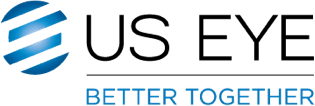
We are a proud partner of US Eye, a leading group of patient-centric, vertically integrated multi-specialty physician practices providing patients with care in ophthalmology, optometry, dermatology and cosmetic facial surgery.




